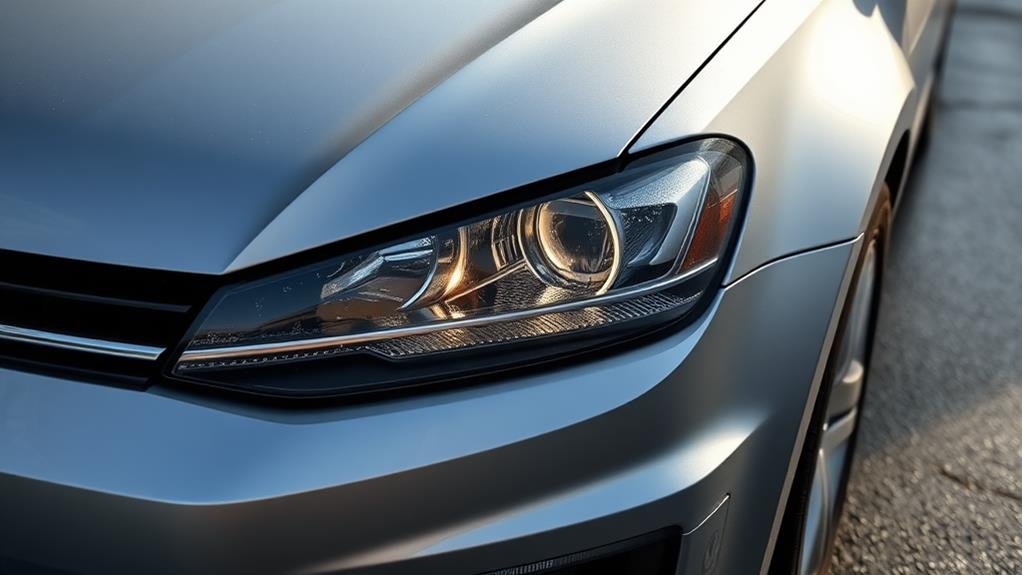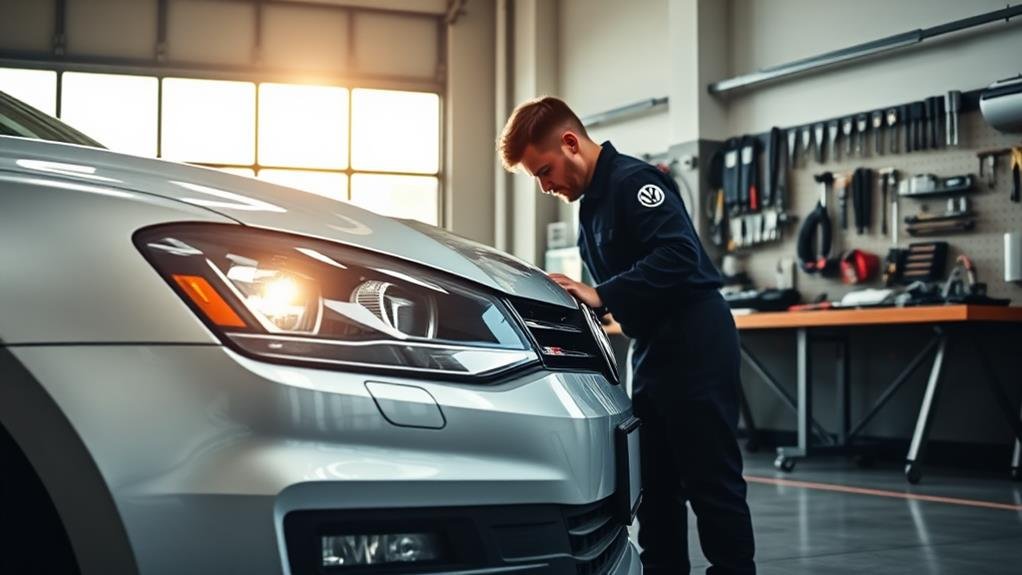Condensation forms inside your VW’s headlights due to a temperature differential between internal and external air, causing moisture accumulation.
Cracks or gaps in the headlight seals often allow external moisture to enter. Polycarbonate lens materials, while durable, may worsen condensation under fluctuating temperatures.
This moisture can scatter headlight beams, reduce visibility, and hamper road safety. Check seals for damage and ensure proper fastening of the headlights to prevent moisture ingress.
DIY solutions include replacing damaged seals and using silica gel packets for moisture absorption.
Regular inspection can significantly improve headlight performance and mitigate condensation effects. Further exploration reveals more details.
Causes of Headlight Condensation

Condensation happens in VW headlights because of the temperature difference between the inside and outside.
Warm, moist air inside meets cooler air outside, causing moisture to gather on the lens. Small gaps in the seal might let outside air in, making it worse.
Headlights have vents to balance pressure, but these can also let in moisture, especially when it’s humid. Washing the car often or driving in the rain can add more moisture inside.
The lens material, usually polycarbonate, can also affect how much condensation forms because of how it handles heat.
Impact on Headlight Performance
Condensation in VW headlights can cause problems with how well they work. When moisture gets inside the headlight, it scatters the light.
This makes it hard for drivers to see clearly, and it can be dangerous. The light beam can become uneven, making the road look lit up in patches.
This not only makes it hard for the driver to spot things on the road, but it can also cause glare for other drivers.
Sometimes, too much moisture can cause electrical problems inside the headlights, which can make them stop working.
Here’s a simple table showing what happens when headlights get condensation:
| What’s Affected | What Happens | Result |
|---|---|---|
| Light Output | Light is scattered by moisture | Harder to see the road |
| Beam Pattern | Light doesn’t spread evenly | Driving becomes risky |
| Electrical Parts | Moisture can cause shorts | Headlights might fail |
Fixing condensation can help keep headlights working well.
Common Signs of Condensation

Condensation in headlights can affect how well they work.
Look for foggy or misty spots inside the headlight, as these can block the light and make it harder to see. If you see small water droplets or water pooling at the bottom, there might be moisture trapped inside. This can cause damage over time.
A yellowish or cloudy film on the lens might also mean there’s condensation, which can change how bright the light is and its color. You might notice the light is uneven or flickers, which can make driving at night less safe.
Checking your headlights regularly can help you spot these problems early. Fixing condensation quickly can stop electrical problems or rust, helping your headlights last longer.
Inspecting Headlight Seals
Check headlight seals regularly to keep moisture out of VW headlights. Seals around the headlights help block water. Over time, they can wear out from sun, debris, and temperature changes.
Look for cracks or gaps. Press gently on the seal; if it feels brittle or hard, it might need replacing.
Make sure the headlight is in place and all clips and fasteners are tight. Fixing bad seals early helps keep moisture away and keeps headlights working well.
Role of Temperature Changes
Maintaining the seals of your VW headlights is important, but changes in temperature also affect how much moisture builds up inside.
When it’s cold outside, the air inside the headlight cools down, causing any moisture to turn into droplets on the lens.
In warmer weather, the air inside expands, and this can let more moisture sneak in through tiny cracks in the seals.
This heating and cooling cycle can make condensation worse.
If you live in a place with a lot of humidity or where the temperature changes a lot, you’ll notice this effect even more.
Knowing how temperature affects your headlights can help you deal with moisture problems.
DIY Fixes for Condensation
To fix condensation in VW headlights, try these DIY methods:
- Check Seals: Look at the headlight seals for any cracks. If they are broken, change them to stop water from getting in.
- Use Silica Gel: Put a silica gel packet inside the headlight housing. It will soak up moisture.
- Add a Vent Hole: Drill a tiny hole at the top of the headlight casing. This improves airflow and lessens humidity.
These steps can help manage moisture in headlights.
Professional Repair Options

Sometimes, fixing condensation in VW headlights needs a professional touch. Certified car experts can help with this. They check everything and fix it right.
These experts have tools to find leaks, change seals, and make sure the headlights have good airflow. They know how to spot problems like broken parts or blocked vents.
When you hire them, you often get a warranty too. This means if the problem comes back, they will handle it. Choosing a professional not only fixes the condensation but also helps your headlights work better for a longer time.
Preventive Measures to Consider
To keep moisture out of your VW headlights, try these easy steps:
- Check the Seals: Look at the headlight seals often. If seals are broken or worn, water can get in. Make sure they are in good shape.
- Add Airflow: Use desiccant packs or ensure there’s good airflow around the headlights. This helps soak up extra moisture and keeps air moving.
- Wash with Care: When washing your car, use low pressure near the headlights. High pressure might push water inside and cause problems.
Following these tips can help keep your headlights clear and working well.
People Also Ask
Can Condensation Inside Headlights Impact Electrical Components of My VW?
Moisture in your VW’s headlights can lead to problems. It might make the lights dim, damage wires, or hurt other parts. This can cause safety issues and make car repairs cost more. So, it’s important to fix any condensation quickly.
How Common Is Headlight Condensation in Newer VW Models?
Newer Volkswagen cars sometimes get foggy headlights because of how they’re made, which lets a little moisture in. But don’t worry! This fog usually goes away fast and doesn’t hurt how the car works or how safe it is.
Are There Any Specific VW Recalls Related to Headlight Condensation Issues?
Volkswagen hasn’t had any recalls just for headlight condensation problems. But, it’s a good idea for car owners to ask their VW dealers if there are any new updates or service advice about these issues.
Could Aftermarket Headlights Reduce the Risk of Condensation?
Aftermarket headlights can help reduce condensation because they often have better seals and vents. But, it’s important to make sure they fit your car and are made well. This way, they work properly and don’t cause any problems.
Is Headlight Condensation Covered Under VW Warranty Policies?
Volkswagen’s warranty might cover headlight condensation if it’s because of a problem with how the car was made. But it can be different for each case. It’s best to check the warranty booklet or ask a VW dealer to be sure.